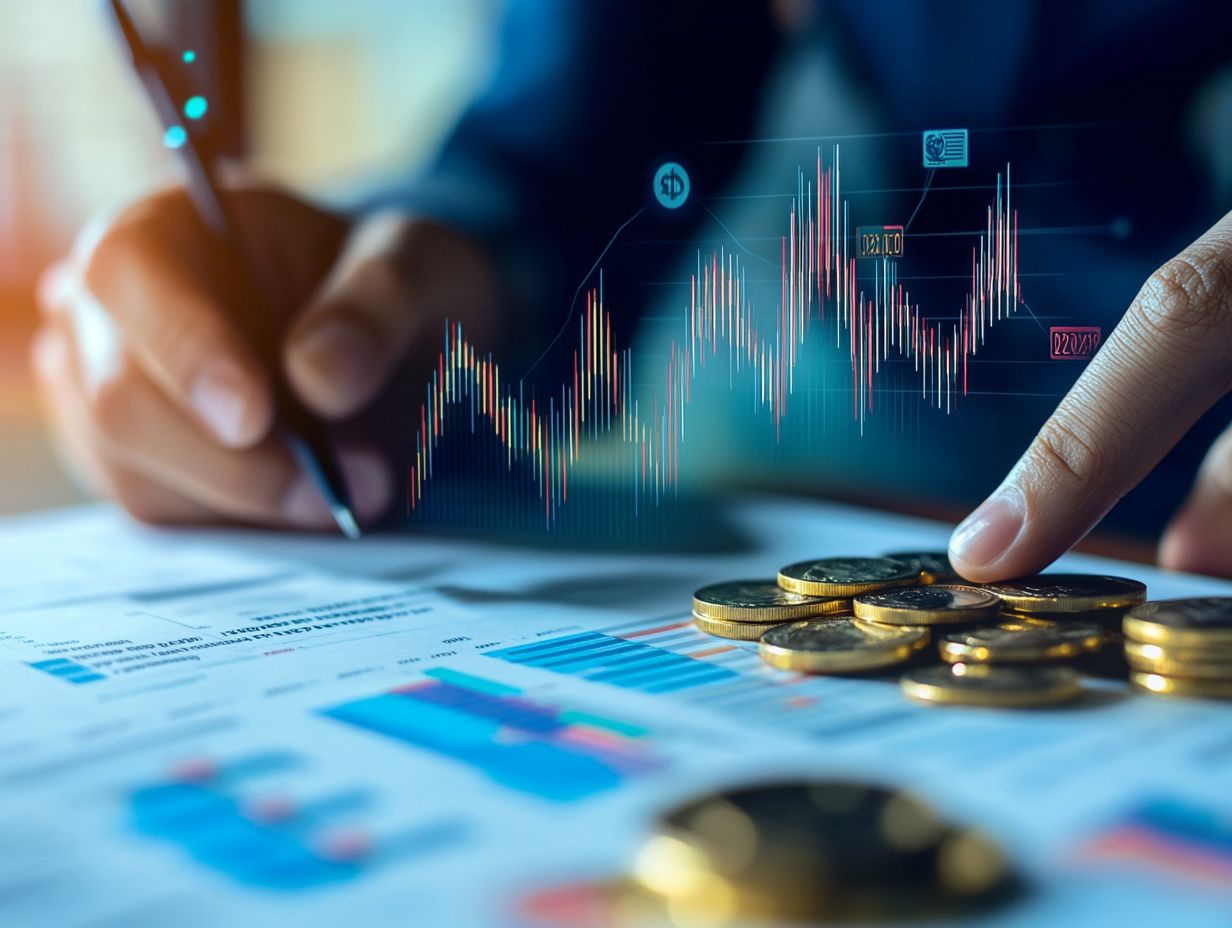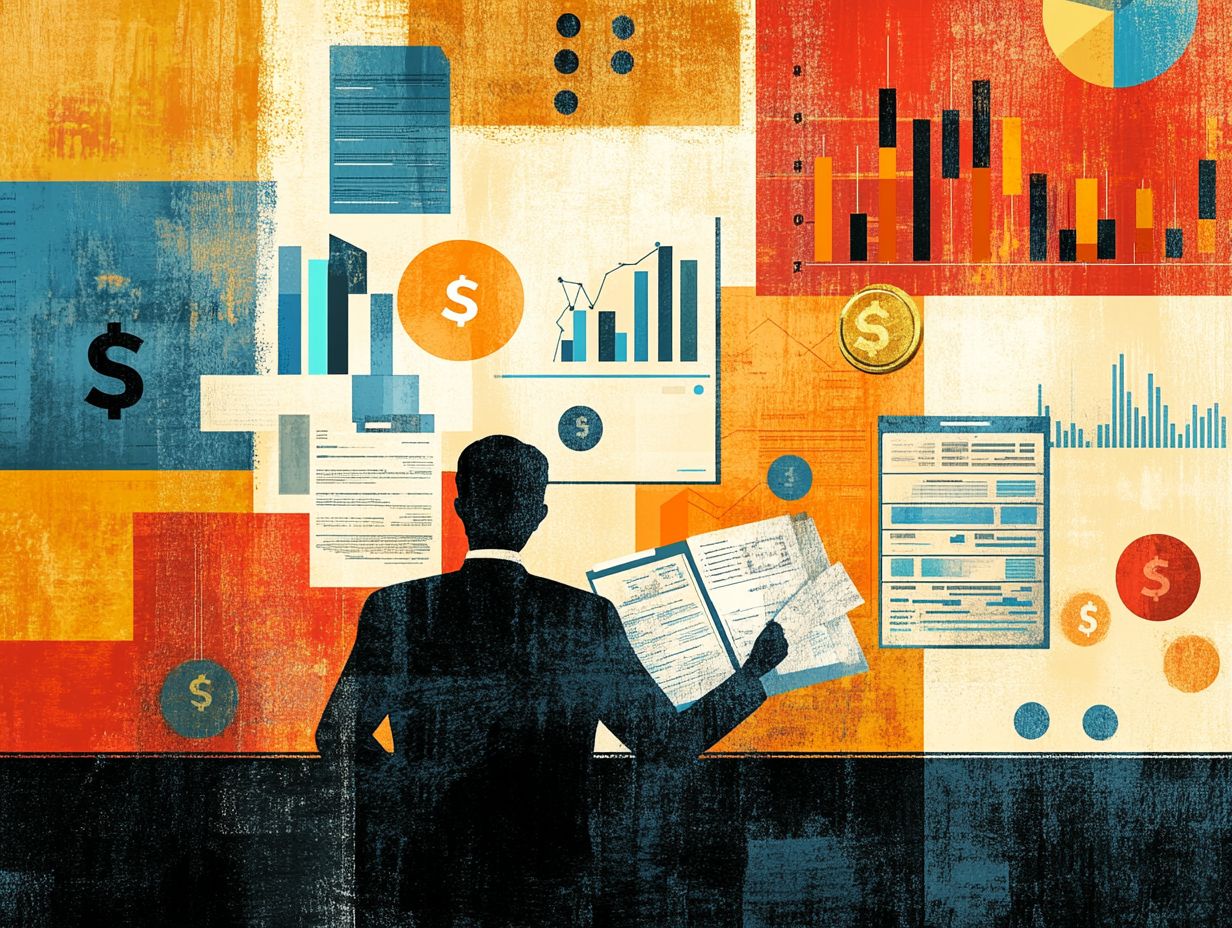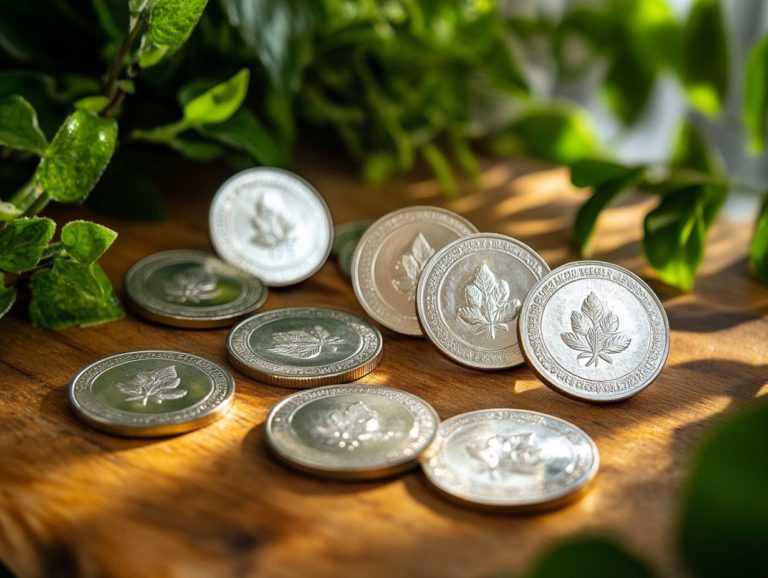Platinum Investment Strategies for Beginners
Platinum, while often eclipsed by gold and silver, stands out as a precious metal with distinct properties and impressive investment potential.
As the allure of alternative assets continues to rise, grasping the nuances of platinum investment becomes vital, whether you’re a seasoned investor or just beginning your journey.
This article delves into the intricacies of the platinum market, shedding light on supply and demand dynamics, various investment types, and effective strategies for navigating this multifaceted landscape.
Whether you re captivated by the idea of owning physical platinum or exploring stocks and ETFs, you ll uncover valuable insights to illuminate your investment path.
Contents
- Key Takeaways:
- Understanding the Platinum Market
- Types of Platinum Investments
- Developing a Platinum Investment Strategy
- Frequently Asked Questions
- What is platinum and why is it a good investment for beginners?
- What are the different types of platinum investment strategies for beginners?
- What are the benefits of investing in platinum for beginners?
- How much should a beginner invest in platinum?
- What are the risks associated with platinum investment for beginners?
- What resources are available for beginners to learn more about platinum investment strategies?
Key Takeaways:

- Consider the current market trends and predictions before investing in platinum to make informed decisions.
- Diversify your platinum investments by considering physical platinum, stocks/ETFs, and futures/options to manage risks.
- Factors such as supply and demand, economic conditions, and geopolitical events play a crucial role in the platinum market and should be considered when developing an investment strategy.
What is Platinum?
Platinum is a rare and precious metal that belongs to the exclusive platinum group metals (PGMs). Its unique properties, such as resistance to corrosion and outstanding catalytic capabilities, set it apart. You ll find platinum in various forms whether it s bullion, coins, or exquisite jewelry playing a pivotal role across multiple industries, particularly in the automotive sector, where it s essential for catalytic converters.
This significant industrial demand, combined with its natural scarcity, elevates its value, making it a highly sought-after asset for investors around the globe.
Beyond its industrial uses, platinum’s versatility shines in electronics, medical devices, and luxurious fine jewelry. With its high melting point and excellent conductivity, it s perfect for crafting high-performance components.
Investors increasingly see platinum not just as a commodity, but as a strategic portfolio diversifier that can withstand economic fluctuations.
As a tangible asset, it serves as a hedge against inflation and currency volatility, enhancing its appeal beyond its industrial function. These remarkable attributes position platinum as a valuable investment vehicle for anyone looking to bolster their financial security.
Why Invest in Platinum?
Investing in platinum presents you with a unique opportunity to diversify your investment portfolio, serving as a hedge against inflation and market volatility especially during uncertain economic times. Its tangible asset nature offers you security and stability, particularly when compared to more traditional investments.
By understanding market conditions and demand, you can make informed decisions that optimize your financial health. Additionally, you can minimize tax effects on profits.
Incorporating this precious metal into your strategy can effectively reduce your overall risk exposure. Platinum has a historical track record of outperforming other commodities during economic uncertainty, making it an enticing option for those looking for potential returns.
Engaging a knowledgeable financial advisor can enhance your investment strategies, ensuring that your decisions align with your personal financial goals and current market trends. This advisory relationship is essential for unlocking new opportunities and cultivating a well-rounded approach to wealth management.
Understanding the Platinum Market
To truly grasp the nuances of the platinum market, you must analyze multiple factors, such as the dynamics of supply and demand, prevailing market trends, and historical platinum prices each swayed by industrial and investment demand.
The intricate interplay of these elements can create notable market cycles and volatility. Therefore, adopting a long-term perspective is crucial to effectively navigate the complexities of this precious metal.
As a strategic asset, platinum’s market conditions can present rewarding opportunities for those who remain informed and adaptable.
Discover how you can start investing in platinum today!
Supply and Demand Factors
Supply and demand in the platinum market depend on various factors. These include mining activities, strong industrial demand from the automotive sector, and the wider economic landscape.
This complex interaction can lead to significant market volatility. It can also cause fluctuations in platinum prices.
Understanding these elements is crucial because they greatly influence the availability of platinum group metals. This, in turn, impacts platinum mining stocks and overall investment demand.
Key players like South Africa, Russia, and Zimbabwe are essential in determining global supply levels. These countries host the largest known reserves of platinum.
However, they face challenges such as labor strikes, regulatory changes, and environmental issues. These challenges can cause production delays and alter market dynamics.
On the demand side, a growing focus on cleaner technologies boosts industrial applications for platinum. This includes usage in catalytic converters and fuel cells.
Investors closely monitor these trends. They recognize that shifts in production capabilities and technological advancements will continuously influence market stability and potential returns.
Market Trends and Predictions

Get ready to dive into the exciting world of platinum investments! Analyzing market trends and predictions involves looking into current and historical prices.
It also means examining investment demand and understanding how industrial demand might shape future projections. By gaining insights from market cycles and various financial products like platinum ETFs, you can capitalize on potential fluctuations.
The ongoing shift toward renewable energy and stricter emissions regulations has elevated platinum’s significance. This is especially true in the automotive and hydrogen fuel cell sectors, which could greatly boost demand.
Economic recovery patterns in key industries send mixed signals. These signals may drive both speculative and industrial investment.
Geopolitical tensions and currency fluctuations can support or disrupt price stability. As these dynamics play out, now is the time to explore options!
Consider adopting diversified strategies that incorporate platinum-related assets. Use ETFs and structured products to manage risks while capturing upside potential.
Types of Platinum Investments
In the realm of platinum investments, you have a wealth of options. You can invest in physical platinum, such as bullion, coins, and bars, or explore financial products like platinum ETFs, stocks, and mutual funds.
Each investment type presents unique advantages, risks, and considerations. This enables you to craft a strategy that aligns with your specific financial goals and storage requirements.
Physical Platinum
Investing in physical platinum means acquiring tangible assets like platinum bullion, coins, and bars. These assets offer a distinct allure for those seeking security and value.
They serve as a hedge against inflation and are regarded as reliable stores of wealth. You can rest easy knowing your investments are safely secured.
Platinum coins and bars come in various sizes, purities, and designs. This appeals to different investors based on personal preferences or investment strategies.
Smaller denominations are often more liquid when you need to cash out. Larger bars might attract those looking to make a more substantial investment.
You also have the flexibility to choose storage options, ranging from home safes to professional vaults. This ensures your assets are protected.
As demand shifts across industries like automotive and jewelry, owning physical platinum can help diversify your investment portfolio. It offers both stability and growth potential.
Ultimately, incorporating tangible assets like platinum into your investment strategy shields you from market fluctuations and provides the satisfaction of holding a physical symbol of wealth.
Platinum Stocks and ETFs
Investing in platinum stocks and ETFs provides a streamlined avenue to access the platinum market without the headaches of physical ownership. ETFs, or Exchange-Traded Funds, are investment funds traded on stock exchanges, just like stocks. Platinum ETFs are designed to track the price of platinum, while platinum stocks represent shares in companies actively involved in mining and production.
This offers a compelling opportunity to capitalize on market trends and potential capital gains.
Understanding the advantages and risks is crucial. On one hand, they enhance diversification within your investment portfolio and often mirror fluctuations in platinum prices, serving as a hedge against inflation.
On the other hand, market dynamics ranging from geopolitical factors and supply chain disruptions can significantly impact the value of these investments.
Choosing the right products depends on your individual risk tolerance, market outlook, and long-term investment goals. It s essential to conduct thorough research and consider seeking professional advice as you navigate this intricate landscape.
Platinum Futures and Options
Platinum futures and options are complex investment tools that allow you to speculate on the future price of platinum, offering opportunities to hedge against market volatility or capitalize on potential gains. These derivatives can be powerful additions to your investment strategy, but they demand a sophisticated understanding of market conditions and trends to navigate effectively.
Grasping the mechanics of these tools is essential, as they provide distinct advantages, such as easy to buy and sell and the flexibility to implement various trading strategies.
By utilizing platinum options, you can establish positions with lower capital requirements compared to outright ownership. However, entering these markets isn t without its risks; price fluctuations and complex market dynamics can add layers of uncertainty.
Add platinum futures and options to your portfolio for better diversification, enabling you to adopt a more robust approach to risk management. Additionally, consider exploring 5 silver investment strategies for beginners to enhance your investment options.
Developing a Platinum Investment Strategy

Crafting a solid platinum investment strategy requires meticulous attention to asset allocation, diversification, and potential investment risks, while also considering the current market landscape.
Tailor your approach to fit your financial objectives whether that means boosting your retirement savings or seizing short-term market opportunities.
Often, collaborating with a knowledgeable financial advisor can provide insights to navigate this complex terrain effectively.
Factors to Consider
When crafting your investment strategy in platinum, consider several key factors, including market conditions, investment risks, and the variety of financial products available.
By understanding how these elements interconnect, you can make informed decisions that enhance portfolio diversification, optimizing potential returns while minimizing your risk exposure.
Along with these foundational concerns, remain vigilant about various economic indicators, such as inflation rates, currency fluctuations, and overall industrial demand for platinum, particularly in sectors like automotive and jewelry.
Geopolitical influences, such as trade policies and mining regulations from key producing countries, can significantly sway prices. It s wise to gauge market sentiment by keeping an eye on news cycles and analyst reports, as collective attitudes can prompt rapid market shifts.
Engaging in continuous research on these factors enables you to adapt your strategies swiftly, ensuring you remain well-informed and ready to capitalize on opportunities in the ever-evolving landscape of platinum investments.
Diversification and Risk Management
Diversification and risk management are essential elements of a robust investment strategy in platinum. By spreading your exposure across various types of investments and financial products, you can effectively mitigate potential losses from market volatility. Thoughtful investment distribution allows you to optimize your portfolio for stability and growth, taking full advantage of platinum’s unique characteristics.
Incorporating physical assets, like bullion and coins, alongside financial instruments such as ETFs and futures contracts, enhances your exposure while minimizing risks. For those interested in precious metals, understanding how to build a gold investment portfolio can be beneficial. Geographical diversification is also crucial; investing in platinum from different regions can shield you from localized economic downturns.
By actively monitoring market trends and conducting regular risk assessments, you can make necessary adjustments to your strategy. This ensures your portfolio remains resilient in the face of changing market conditions. This proactive strategy not only safeguards your investments but also helps you seize amazing opportunities, such as those outlined in 5 gold investment strategies for beginners, as the platinum market evolves.
Frequently Asked Questions
What is platinum and why is it a good investment for beginners?
Platinum is a precious metal that is rare and valuable. It is a good investment for beginners because it is a tangible asset that can hold its value over time, making it a reliable long-term investment.
What are the different types of platinum investment strategies for beginners?

There are several types of platinum investment strategies for beginners, including buying physical platinum, investing in platinum stocks, and purchasing platinum through ETFs or mutual funds.
What are the benefits of investing in platinum for beginners?
Investing in platinum can diversify a beginner’s investment portfolio, hedge against inflation, and potentially provide higher returns due to its limited supply and high demand in various industries.
How much should a beginner invest in platinum?
The amount a beginner should invest in platinum depends on their financial goals and budget. It is recommended to start with a small amount and gradually increase as you become more knowledgeable about platinum investments.
What are the risks associated with platinum investment for beginners?
Like any investment, there are risks associated with platinum, including fluctuations in market prices, potential scams, and limited liquidity in certain types of investments.
What resources are available for beginners to learn more about platinum investment strategies?
Many resources are available for beginners to learn about platinum investment strategies, including books, online articles, financial advisors, and reputable investment websites. It is important to conduct thorough research and consult with experts before making investment decisions.
Ready to explore platinum investments? Start your journey today!















